W. G. Bagnall
W. G. Bagnall was a locomotive manufacturer from Stafford, England which was founded in 1875 and operated until it was taken over in 1962 by English Electric.
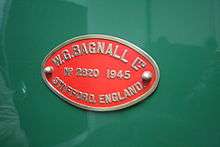 | |
| Ltd | |
| Industry | Engineering |
| Fate | Taken over |
| Successor | English Electric |
| Founded | 1875 |
| Founder | William Gordon Bagnall |
| Defunct | 1962 |
| Headquarters | Stafford, United Kingdom |
Key people | William Gordon Bagnall Ernest E. Baguley |
| Products | Locomotive manufacture Engine manufacture Rails Sleepers Spare parts Boilers |
History
The company was founded in 1875 by William Gordon Bagnall.[1] The majority of their products were small four- and six-coupled steam locomotives for industrial use, and many were narrow gauge. They were noted for building steam and Diesel locomotives in standard and narrow gauges. Some of Kerr Stuart's designs were brought to Bagnalls when they employed Kerr Stuart's chief Draughtsman. Examples of such locomotives can be seen on the Sittingbourne & Kemsley Light Railway.
In 1951, the company was sold to Brush Electrical Engineering, becoming Brush-Bagnall Traction, Ltd.[1] In 1959, Bagnall's merged with local engine manufacturer Dorman Diesels;[2] however in 1962 both were taken over by English Electric Co Ltd.[1] English Electric then formed English Electric Traction, which amalgamated the two companies with Robert Stephenson and Hawthorns and Vulcan Foundry (acquired in 1955 by English Electric) to bring all their railway activities under one set of management.
Location
The company was located at the Castle Engine Works, in Castletown, Stafford. The factory has been demolished. Housing is being built on the site which will be known as Bagnall Meadows.
Design
Bagnalls introduced several novel types of locomotive valve gear including the Baguley and the Bagnall-Price.[3] They also used marine (circular) fireboxes on narrow gauge engines, a design that was cheap but needed a different firing technique.
Bagnall also developed the inverted saddle tank. The two tanks were joined underneath the smokebox and supported the smokebox. Bagnall also commonly used the saddle tank which carries the water on top of the boiler.
Bagnalls also produced pannier tank locomotives, such as the GWR 5700 Class of which Bagnall produced 100 of the class for the Great Western Railway from 1930 under lot number 262 and in 1931 under lot number 272. Bagnall also produced the GWR 9400 Class in two orders, 1949-51 lot number 384 and in 1953-54 to the same lot number. Bagnall produced their own pannier tank designs, examples of such can be seen at the Mangapps Railway Museum in Essex.
Bagnall designed possibly the most advanced steam locomotive and one of the most powerful: the 0-6-0ST Victor/Vulcan locomotives.
Steam locomotives
The company built many locomotives for use both domestically and for export.[4][5][6]
Bagnalls also created locomotives for the Great Western Railway and the London, Midland and Scottish Railway in the form of the GWR 5700 Class, the GWR 9400 Class and the LMS Fowler Class 3F.
During World War II, Bagnall was subcontracted work for the Hunslet Austerity 0-6-0ST which resulted in 52 being manufactured from 1943 to 1947.
The Great Western Railway Bagnall GWR 9400 Class was numbered 8400–8449 and numbers 8400 to 8406 were employed on the former L.M.S. system at Bromsgrove giving banking assistance on the Lickey Incline.
Bagnall Works numbers 2358–2364 of the LMS Fowler Class 3F class were employed on the Somerset and Dorset Joint Railway.
LMS Fowler Class 3F No. 16539 (In the LMS 1934 renumbering scheme it became No.7456) was built by Bagnall in 1926 was one of two locomotives regauged by the London, Midland and Scottish Railway for the Northern Counties Committee, the other locomotive was built by Hunslet Engine Company of Leeds which lasted until 1963, the Bagnall lasted until 1956 when a suspect crank pin led to her early withdrawal.
The Victor/Vulcan 2994-6 locomotives were ordered by the Steel Company of Wales (SCOW) for their Abbey, Margam and Port Talbot works in 1950. They had a whole range of advanced features, such as 18" X 26" cylinders, together with piston valves, roller-type big-end and side-rod bearings, manganese steel axle-box and horn plate liners, hopper ashpans, self-cleaning smokeboxes, rocking grates and Lambets wet sanding. Steel fireboxes were used as well as "Owens" patent poppet valve and balanced regulator valves though surprisingly the locomotives weren't fitted with superheating. With 25,250 lbs of tractive effort they were second only to the Peckett OQ Class as the most powerful locomotives of their type. In later life 2994 and 2996 were sold to Austin Motor company and were named 'Victor' and 'Vulcan' . They ran until 1972 when the locomotives were preserved on the West Somerset Railway and currently run at the Stephenson Railway Museum and the Lakeside and Haverthwaite Railway. 2995 was sold to NCB at the same time for use at a colliery and was scrapped in 1967.
Diesel locomotives
Bagnall also manufactured diesel locomotives. An example of this is the New Zealand TR class locomotive which W.G Bagnall built seven TRs in 1956-57.
Electric locomotives
Bagnall also manufactured electric locomotives. Bagnalls worked with Siemens at the Siemens Stafford works to supply the electrical equipment for the locomotives.
Paraffin locomotives
Parraffin Locomotives was one of Bagnall's specialities and appear in most catalogues that Bagnall created.
Scale models
There are few W.G. Bagnall RTR (ready to run) locomotives and kit locomotives. Here are a few examples.
Bachmann Branchline currently produce the OO gauge version of the LMS Fowler Class 3F which Bagnall built and Bachmann are currently manufacturing the Somerset and Dorset Joint Railway liveried Fowler 3F which has been correctly numbered to number 23 which is a number of one of the Bagnall 3Fs, it also features printed Bagnall name plates.
Mercian Models produce possibly Bagnall's most advanced locomotive to date in 7mm scale (O gauge) The Victor/Vulcan locomotives are in two forms; the complete kit which features the body kit, frames, detailing, motor, gearbox and wheels, and the kit only option which features everything except the motor, gearbox and wheels.
There are a few custom kits as well. If you look at the gallery there is an O16.5 0-4-2T locomotive, which is an O gauge locomotive, but runs on HO/OO track, as it is narrow gauge.
In 2014, Hornby introduced a representation of a preserved four-wheeled Diesel shunter into their budget Railroad range utilising the body from "Dart" from the Thomas The Tank Engine range.[7]
Gallery
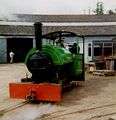 0-4-0ST Woto at Alan Keef Ltd., 1999
0-4-0ST Woto at Alan Keef Ltd., 1999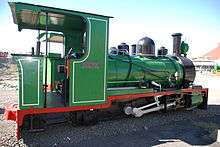
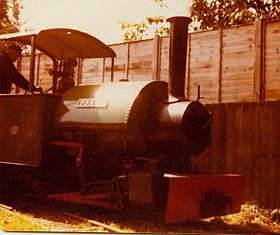 Saddle tank narrow gauge locomotive no 2090 Pixie, on the Cadeby Light Railway in 1981
Saddle tank narrow gauge locomotive no 2090 Pixie, on the Cadeby Light Railway in 1981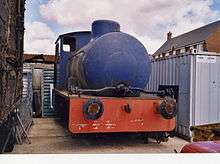 Huntley & Palmers No.1, Bagnall 0-4-0F preserved at Cholsey and Wallingford Railway
Huntley & Palmers No.1, Bagnall 0-4-0F preserved at Cholsey and Wallingford Railway- 0-4-0ST 2067/1917 'Peter' on the pottery line on the Amberley Museum Railway.
 An O16.5 model based on a Bagnall 0-4-2T design
An O16.5 model based on a Bagnall 0-4-2T design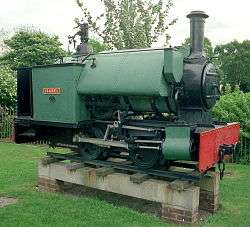 Cliffe Hill Mineral Railway locomotive Isabel, preserved on a plinth in Stafford in 1974. Now running at Amerton Railway.
Cliffe Hill Mineral Railway locomotive Isabel, preserved on a plinth in Stafford in 1974. Now running at Amerton Railway. Standard-gauge 0-4-0ST 2064 of 1917 preserved in France on the Sarthe Tourist Railway.
Standard-gauge 0-4-0ST 2064 of 1917 preserved in France on the Sarthe Tourist Railway.
Preservation
| Location | Name | Works Number | Built | Arrangement | Gauge | Notes |
|---|---|---|---|---|---|---|
| Amberley Museum Railway | Polar Bear | 1781 | 1905 | 2-4-0T | 2 ft (610 mm) | Originally built for the Groudle Glen Railway on the Isle of Man, Polar Bear was acquired by the Brockham Museum Trust soon after the GGR closed. Her sister engine, Sea Lion, still works on the GGR. Polar Bear came to Amberley Museum and Heritage Centre when the Brockham collection was transferred there in 1982. Currently in service. |
| Amberley Museum Railway | Peter | 2067 | 1917 | 0-4-0ST | 2 ft (610 mm) | Peter was built as a 3 ft gauge engine for the Canadian Forestry Commission. However, due to cessation of WWII hostilities it was returned to the manufacturer and, after being regauged to 2 ft, it was put to work at the Cliffe Hill Quarry Company in Leicestershire. It worked here until 1949 when it was stored out of service. Peter was then acquired by the Narrow Gauge Railway Society and eventually came to Amberley with the Brockham Collection along with Polar Bear. Currently in service. |
| Bursledon Brickworks | Wendy | 2091 | 1919 | 0-4-0ST | 2 ft (610 mm) | Wendy is a 2 ft gauge Quarry Bagnall formerly used at the Dorothea Quarry in North Wales. She is currently based at the Hampshire Narrow Gauge Railway Trust's Bursledon Brickworks base. |
| Amerton Railway | Isabel | 1491 | 1897 | 0-4-0ST | 2 ft (610 mm) | a typical Bagnall narrow gauge loco — this locomotive was for many years on public display opposite Stafford Railway Station before it was restored to use. |
| East Anglian Railway Museum | Lamport No.3 | 2670 | 1942 | 0-6-0ST | 4 ft 8 1⁄2 in (1,435 mm) | One of a batch of 6 similar locomotives supplied to the Staveley Coal and Iron Company. Overhaul in progress, repairs to bunker and cab completed. Main effort is now concentrated on overhauling the boiler including replacing the old steel firebox with a new all welded replacement. |
| Chasewater Railway | Dunlop No. 6 | 2648 | 1940 | 0-4-0ST | 4 ft 8 1⁄2 in (1,435 mm) | the first of a batch of 9 supplied to the Ministry of Supply for use at Royal Ordnance Factories |
| Chasewater Railway | No. 2 | 2842 | 1946 | 0-4-0ST | 4 ft 8 1⁄2 in (1,435 mm) | built for the Kent Electric Power Company at Littlebrook Power Station, near Dartford |
| Bodmin and Wenford Railway | No. 19 | 2962 | 1950 | 0-4-0ST | 4 ft 8 1⁄2 in (1,435 mm) | |
| Bodmin and Wenford Railway | Alfred | 3058 | 1953 | 0-4-0ST | 4 ft 8 1⁄2 in (1,435 mm) | |
| Bodmin and Wenford Railway | Judy | 2572 | 1937 | 0-4-0ST | 4 ft 8 1⁄2 in (1,435 mm) | |
| Bodmin and Wenford Railway | 3121 | 1957 | 0-4-0F | 4 ft 8 1⁄2 in (1,435 mm) | Rare fireless locomotive | |
| Bodmin and Wenford Railway | 2766 | 1944 | 0-6-0ST | 4 ft 8 1⁄2 in (1,435 mm) | J94 class | |
| Bredgar & Wormshill Light Railway | Armistice | 2088 | 1919 | 0-4-0ST | 2 ft (610 mm) | Birmingham, Tame & Rea District Drainage Board Railway, Minworth, England |
| Cripple Creek and Victor Narrow Gauge Railroad | No. 4 | 2831 | 1947 | 0-4-4-0T | 2 ft (610 mm) | Located in Cripple Creek, Colorado, United States, and used as season tourist train in one of Colorado's old mining districts |
| Foxfield Light Railway | Hawarden | 2623 | 1940 | 0-4-0ST | 4 ft 8 1⁄2 in (1,435 mm) | built for Butterley Company's steelworks, Ripley, Derbyshire |
| Foxfield Light Railway | Florence No. 2 | 3059 | 1954 | 0-6-0ST | 4 ft 8 1⁄2 in (1,435 mm) | built for the NCB North Staffordshire Area |
| Foxfield Light Railway | Lewisham | 2221 | 1927 | 0-6-0ST | 4 ft 8 1⁄2 in (1,435 mm) | built for the Shropshire Beet Sugar Company at Alscott, near Wellington |
| Foxfield Light Railway | Leys | 3027 | 1961 | 0-4-0DH | 4 ft 8 1⁄2 in (1,435 mm) | the last-but-one locomotive built by W G Bagnall |
| Groudle Glen Railway | Sea Lion | 1486 | 1896 | 2-4-0T | 2 ft (610 mm) | Originally built for the Groudle Glen Railway and operated in the glen until the Second World War. She was then left to rust outside the engine shed, and used for spart parts for Polar Bear until after the railway ceased operating in 1963. The rusted locomotive was rescued from the glen, and following a number of years as a static exhibit she was rebuilt as an Apprentice training project by British Nuclear Fuels at Sellafield in 1987 and returned to service on the Groudle Glen Railway in 1987, which in the meantime had been restored by a group of volunteers. |
| Hong Kong Railway Museum | 2227 | 1928 | 0-4-4T | 2 ft (610 mm) | ex Sha Tau Kok Railway | |
| Bradford, West Yorkshire[8] | Huntley & Palmers No.1 | 2473 | 1932 | 0-4-0F | 4 ft 8 1⁄2 in (1,435 mm) | Fireless locomotive |
| Lakeside and Haverthwaite Railway | Victor | 403 | 1950 | 0-6-0 | 4 ft 8 1⁄2 in (1,435 mm) | Under restoration at the Lakeside and Haverthwaite Railway |
| Mangapps Railway Museum | Brookfield | 2613 | 1940 | 0-6-0PT | 4 ft 8 1⁄2 in (1,435 mm) | No 2613 was originally designed as a narrow gauge locomotive to go to work in the coal fields in Turkey. But just as construction was starting it was commandeered as part of the war effort and built as standard gauge. It is currently used at the Mangapps Railway Museum in Essex |
| Vale of Rheidol Railway | 2228 | 1928 | 0-4-4T | 2 ft (610 mm) | ex Sha Tau Kok Railway | |
| Vale of Rheidol Railway | Conqueror | 2192 | 1922 | 0-6-2T | 2 ft 6 in (762 mm) | ex Bowaters Paper Railway and Great Whipsnade Railway |
| Phyllis Rampton Trust | 2895 | 1948 | 0-4-2ST | 2 ft (610 mm) | ||
| Privately owned — Peter Rampton | 2029 | 1916 | 2-6-2T | 2 ft 6 in (762 mm) | ||
| Vale of Rheidol Railway | 2460 | 1932 | 4-6-2 | 2 ft (610 mm) | ||
| Vale of Rheidol Railway | 2457 | 1932 | 4-6-2 | 2 ft (610 mm) | ||
| Privately owned — Peter Rampton | 2545 | 1936 | 0-4-4-0T | 600 mm (1 ft 11 5⁄8 in) | ex Renishaw Sugar Mill, South Africa | |
| Plym Valley Railway | Byfield | 2655 | 1942 | 0-6-0ST | 4 ft 8 1⁄2 in (1,435 mm) | Built to work at Byfield Ironstone Quarry in Northamptonshire. Overhaul is expected to start very soon |
| Rushden, Higham & Wellingborough Railway | Cherwell | 2654 | 1942 | 0-6-0ST | 4 ft 8 1⁄2 in (1,435 mm) | built for the Byfield Ironstone Co's quarry |
| Rutland Railway Museum | "Cranford" No 2. | 2668 | 1942 | 0-6-0ST | 4 ft 8 1⁄2 in (1,435 mm) | Awaiting overhaul, boiler ticket expired in 2006. |
| Welsh Highland Railway | Sinembe | 2287 | 1927 | 4-4-0T | 2 ft (610 mm) | built for the Tongaat Sugar Estates, Natal. |
| Welsh Highland Railway | Gelert | 3050 | 1953 | 0-4-2T | 2 ft (610 mm) | built for the Rustenburg Platinum Mines in South Africa. |
| Lynton and Barnstaple Railway | Isaac | 3023 | 1953 | 0-4-2T | 2 ft (610 mm) | built for the Rustenburg Platinum Mines in South Africa. |
| Welshpool and Llanfair Light Railway | Monarch | 3024 | 1953 | 0-4-4-0T | 2 ft 6 in (762 mm) | built for the Bowaters Paper Railway in Kent. This was last narrow gauge steam locomotive built for industrial service in the UK.[9] |
| Stephenson Railway Museum | Thomas Burt MP | 401 | 1950 | 0-6-0 | 4 ft 8 1⁄2 in (1,435 mm) | Originally named "Vulcan" it was part of a batch of three built for the Steel Company of Wales, they were used at their Abbey, Margam and Port Talbot Steelworks. Replaced by diesels in 1957, 2994 and 2996 were sold in September to the Austin Motor Company of Longbridge plant, Birmingham. No.402 went to the N.C.B. in South Wales, and was scrapped in 1967. Sold to the West Somerset Railway, 401 and 403 become the core of the WSR's early motive power. Replaced by authentic GWR locomotives, 401 was sold to the Stephenson Railway Museum, where it was renamed "Thomas Burt MP" and worked until 2009, and currently undergoing overhaul. 403 was sold to the Lakeside and Haverthwaite Railway.[10] |
| East Anglian Railway Museum | Jubilee | 2542 | 1936 | 0-4-0 | 4 ft 8 1⁄2 in (1,435 mm) | Built for Bowaters Paper Railway. Returned to traffic in 2016, painted in lined light green. |
| Muzium Negara | FMSR No. 13 → MR 321.01 |
2323 | 1928 | 0-6-2T | 3 ft 6 in (1,067 mm) | One of five lightweight shunters used on the wharves in Port Swettenham and Singapore. Originally owned by the Federated Malay States Railways and Malayan Railways. Sold to Pan-Malayan Cement in 1965 and painted green, but returned to MR and cosmetically restored with black MR livery in 1972. Placed on display beside Muzium Negara in 1973. |
| Usina São João in Santa Rita, PB | USJ #3 "João Felipe" | 1737 | 1903 | 0-4-0ST+T | 3 ft 3 3⁄8 in (1,000 mm) | Unmounted. |
| Usina Santa Tereza in Goiana, PE | "Santa Tereza" (ex "Catu"; unnumbered) | 1981 | 1913 | 0-4-2T | 2 ft 5 1⁄2 in (750 mm) | Operated before at Usina Nossa Senhora das Maravilhas, also in the state of Pernambuco, where her name used to be "Catu". |
| Rambagh Palace Hotel, Jaipur, India | 4 | 2009 | 1914 | 0-6-4T | 2 ft 6 in (762 mm) | Originally Burdwan–Katwa Railway No. 4 S. C. Ghose (Part of the McLeods Light Railways group) |
Operational
- BN 1965 0-6-0 Powelltown Tramway[11]
See also
- Bagnall fireless locomotives (preserved)
- Bagnall 0-6-0ST Victor/Vulcan
- Bagnall 0-4-0ST "Alfred" and "Judy"
- Bagnall 0-4-0ST No. 19
- Bagnall boiler
References
- Kerr, Fred (2017). "Bag: W.G. Bagnall & Company". Steam at Work: Preserved Industrial Locomotives. Casemate Publishers. pp. n.p. ISBN 978-1473896598 – via Google Books.
- "Company Affairs: W. H. Dorman and Co". The Guardian. London. 3 February 1959. p. 10 – via Newspapers.com.

- "Books, Papers, and Pamphlets". The Railway Engineer. Vol. XXV no. 12. December 1904. p. 382 – via Google Books.
- "House of Commons, Monday". Wrexham Advertiser. Wrexham, Clwyd, Wales. 14 March 1885. p. 7 – via Newspapers.com.

- "Home and Overseas Railways; Important Contracts for British Engineers". The Guardian. London. 19 July 1929. p. 19 – via Newspapers.com.

- "A Small Locomotive". Snyder County Tribune. Middleburg, Pennsylvania. 18 August 1881. p. 1 – via Newspapers.com.

- "xp64mag.co.uk".
- Griffiths, Kathie (3 July 2009). "Est Bierley, Bradford, man's surprise gift". Telegraph and Argus.
- "Locomotives". Welshpool & Llanfair Light Railway.
- "Bagnall 0-6-0 Saddle Tanks 2994 - 2996". North Tyneside Steam Railway Association. Archived from the original on 26 June 2015. Retrieved 7 July 2015.
- Light Railways. April 2010. Missing or empty
|title=(help)
External links
| Wikimedia Commons has media related to W. G. Bagnall locomotives. |